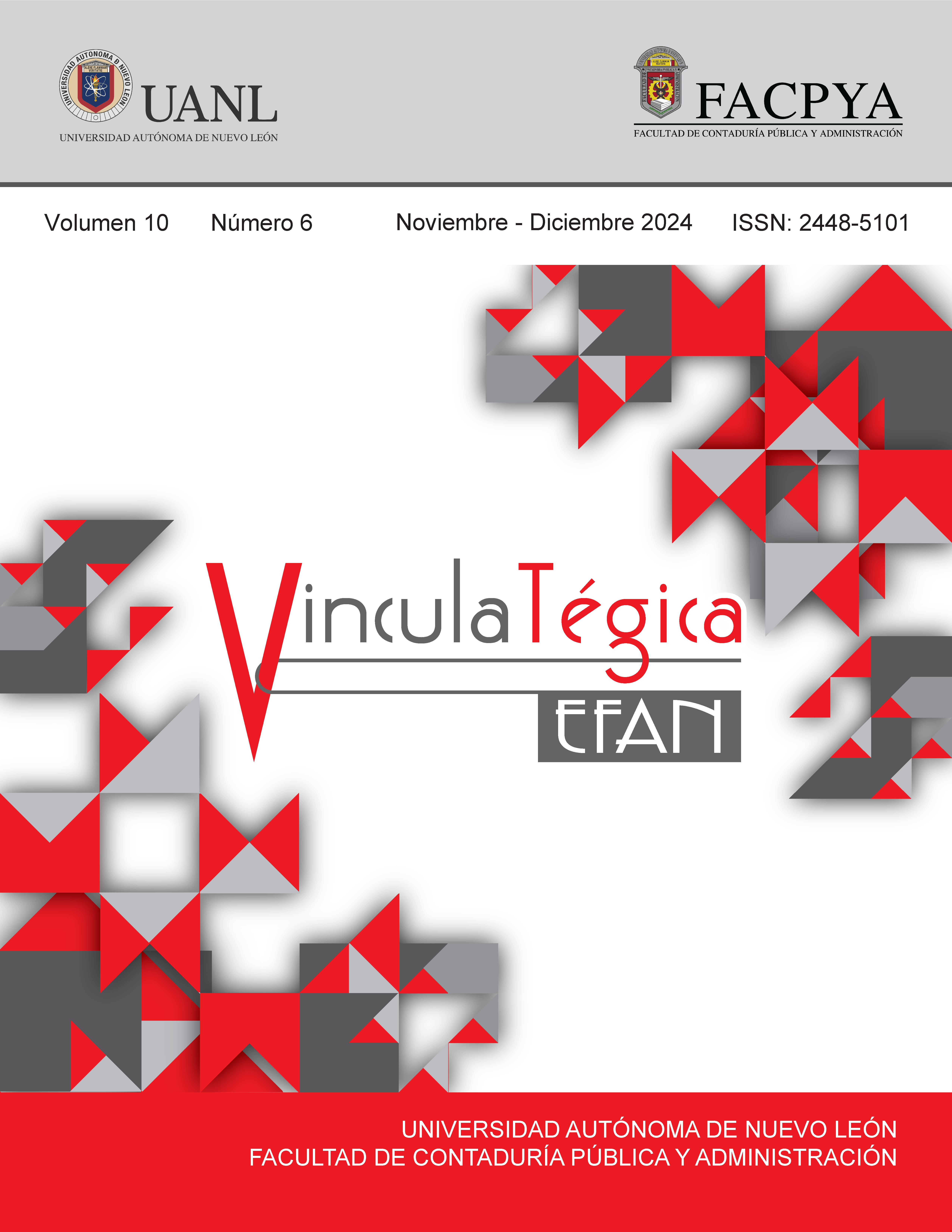Los efectos de la IA en el bienestar de los empleados en las organizaciones
DOI:
https://doi.org/10.29105/vtga10.6-994Palabras clave:
Bienestar de los empleados, Inteligencia Artificial, Inteligencia OrganizacionalResumen
El objetivo de la presente investigación es describir los efectos del uso de la Inteligencia Artificial (IA) en el Bienestar de los empleados, y la importancia de la capacitación para el proceso de adaptación hacia la Inteligencia Organizacional, a través de una revisión de literatura, presentando definiciones, dimensiones e investigaciones aplicadas. La metodología aplicada es con enfoque cualitativo y de alcance descriptivo, con técnicas documentales y bibliográficas. En los resultados se presentan las principales definiciones y dimensiones, que fundamentan el modelo gráfico de las hipótesis planteadas para un estudio más completo y hacer la comprobación de estas. Concluyendo, el uso de la IA beneficia a las organizaciones y ayuda a mejorar el bienestar de los empleados, solo si se disminuye el esfuerzo físico y psicológico de estos, lo cual se puede lograr con la capacitación adecuada.
Descargas
Citas
Acemoglu, D. y Restrepo, P. (2020). Robots and jobs: Evidence from US labor markets. Journal of Political Economy, 128(6), 2188–2244. https://www.journals.uchicago.edu/doi/abs/10.1086/705716 DOI: https://doi.org/10.1086/705716
Austmine SmartMining (Agosto de 2021). Mining Leaders Turn to Enable People and Performance [Comunicado de prensa]. https://austmine.imiscloud.com/Web/Web/News-Resources/Articles/2021/July/Mining-Leaders-Turn-to-Technology-to-Enable-People-and-Performance.aspx
Banco Mundial, (14 de julio de 2020). El aumento de la productividad, el principal motor de reducción de la pobreza, corre peligro debido a las perturbaciones causadas por la COVID-19 [Comunicado de prensa]. https://www.bancomundial.org/es/news/press-release/2020/07/14/productivity-growth-threatened-by-covid-19-disruptions
Bakker, A. B. y Demerouti, E. (2007). The job demands‐resources model: State of the art. Journal of managerial psychology, 22(3), 309-328. https://doi.org/10.1108/02683940710733115 DOI: https://doi.org/10.1108/02683940710733115
Brougham, D. y Haar, J. (2018). Smart technology, artificial intelligence, robotics, and algorithms (STARA): Employees’ perceptions of our future workplace. Journal of Management & Organization, 24(2), 239–257. https://doi.org/10.1017/jmo.2016.55 DOI: https://doi.org/10.1017/jmo.2016.55
Buckley, R. y Caple, J. (2009). The theory and practice of training. Kogan Page Publishers. https://books.google.mg/books?id=HpQhYbF64aUC&printsec=copyright#v=onepage&q&f=false
Campbell, A. (1976). Subjective measures of well-being. American psychologist, 31(2), 117. https://doi.org/10.1037/0003-066X.31.2.117 DOI: https://doi.org/10.1037//0003-066X.31.2.117
Chatterjie, S. y Nandi, S. (2023). The Perception of Impacts of Work from Home on Employee Well-being. Indian Journal of Industrial Relations, 59(2), 335-347. https://research.ebsco.com/linkprocessor/plink?id=7e296a1c-cc03-3a6b-a8b2-b8135b8eeb54
Chen, C.J. y Huang, J.W. (2009) Strategic human resource practices and innovation performance the mediating role of knowledge management capacity. Journal of Business Research, 62, 104– 114. https://doi.org/10.1016/j.jbusres.2007.11.016 DOI: https://doi.org/10.1016/j.jbusres.2007.11.016
Choi, D. Y. y Kang, J. H. (2019). Net job creation in an increasingly autonomous economy: The challenge of a generation. Journal of Management Inquiry, 28(3), 300–305. https://doi.org/10.1177/1056492619827372 DOI: https://doi.org/10.1177/1056492619827372
Coppola, M. (7 de marzo de 2024). Tipos de inteligencia artificial que puedes usar este 2024. https://blog.hubspot.es/marketing/tipos-inteligencia-artificial#cinco
Creswell, J. W. y Creswell, J. D. (2017). Research design: Qualitative, quantitative, and mixed methods approaches. Sage publications.
Delgado, B. M., Alvarado, W. P. y Ortega, M. V. (2021). La capacitación laboral como herramienta de mejoramiento empresarial. Boletín Redipe, 10(6), 305-317. https://doi.org/ 10.36260/rbr.v10i6.1327 DOI: https://doi.org/10.36260/rbr.v10i6.1327
Demerouti, E., Bakker, A. B., Nachreiner, F. y Schaufeli, W. B. (2001). The job demands-resources model of burnout. Journal of Applied psychology, 86(3), 499. https://doi.org/10.1037/0021-9010.86.3.499 DOI: https://doi.org/10.1037//0021-9010.86.3.499
DiClaudio, M. (2019). People analytics and the rise of HR: How data, analytics and emerging technology can transform human resources (HR) into a profit center. Strategic HR Review, 18(2), 42–46. https://doi.org/10.1108/SHR-11-2018-0096. DOI: https://doi.org/10.1108/SHR-11-2018-0096
Diener, E. (1984). Subjective Well-Being. Psychological Bulletin, 95 (3), 542-575. Diener54295Psychological Bulltein1984. https://ssrn.com/abstract=2162125 DOI: https://doi.org/10.1037//0033-2909.95.3.542
Diener, E., Sandvik, E., Pavot, W. y Gallagher, D. (1991). Response artifacts in the measurement of subjective well-being. Social Indicators Research, 24(1), 35-56. https://doi.org/10.1007/BF00292649 DOI: https://doi.org/10.1007/BF00292649
Diener, E. y Fujita, F. (1995). Resources, Personal Strivings, and Subjective Well-Being: A Nomothetic and Idiographic Approach. Journal of Personality and Social Psychology, 68(5), 926–935. https://doi.org/10.1037/0022-3514.68.5.926 DOI: https://doi.org/10.1037//0022-3514.68.5.926
Durth, S., Hancock, B., Maor, D., Sukharevsky, A. (19 de septiembre de 2023). La organización del futuro: Habilitada por la IA generativa, impulsada por las personas. McKinsey & Company. https://www.mckinsey.com/featured-insights/destacados/la-organizacion-del-futuro-habilitada-por-la-ia-generativa-impulsada-por-las-personas/es
Fahim, S. M., Bano, S., Ahmed, S. F., Munawar, S. y Saleem, S. M. (2023). Retaining Employees with Adoption of Industry 4.0 Technologies in the Automotive Sector-Mediation of Training 4.0 & Employee Competency. Journal of Organisational Studies & Innovation, 10(3), 17–36. https://doi.org/10.51659/josi.22.181 DOI: https://doi.org/10.51659/josi.22.181
Gallart, M. A. (2001). La articulación entre el sector público y la empresa privada en la formación profesional de América Latina. CEPAL Repositorio dgital Beta. https://hdl.handle.net/11362/31624
García-Allen (12 de diciembre de 2015). Los beneficios de la inteligencia emocional en el trabajo. Psicología y mente. https://psicologiaymente.com/organizaciones/beneficios-inteligencia-emocional-trabajo
González-Trejo, E. S., García-González, M. A. y Pedroza-Cantú, G. (2020). ¿Conocen los jóvenes millennials los requerimientos para la transformación digital de las organizaciones?. Vinculatégica EFAN, 6(1), 672–681. https://doi.org/10.29105/vtga6.1-621 DOI: https://doi.org/10.29105/vtga6.1-621
Grant, A. M., Christianson, M. K. y Price, R. H. (2007). Happiness, health, or relationships? Managerial practices and employee well-being tradeoffs. Academy of management perspectives, 21(3), 51-63. https://doi.org/10.5465/amp.2007.26421238 DOI: https://doi.org/10.5465/amp.2007.26421238
Haepp, T. (2022). New technologies and employee well-being: the role of training provision. Applied Economics Letters, 29(13), 1211–1216. https://doi.org/10.1080/13504851.2021.1922579 DOI: https://doi.org/10.1080/13504851.2021.1922579
Hadi, N. y Ahmed, S. (2018). “Role of Employer Branding Dimensions on Employee Retention: Evidence from Educational Sector”. Administrative Science, (8)44, 1-15. https://doi.org/10.3390/admsci8030044 DOI: https://doi.org/10.3390/admsci8030044
Hussain, A., Apostu, S. A., Kijkasiwat, P. y Vasa, L. (2022). A cross-country study on the determinants of working capital management: GMM approach. Transformations in Business & Economics, 21(3), 42-59. https://www.researchgate.net/publication/365823346_A_Cross-country_Study_on_the_Determinants_of_Working_Capital_Management_GMM_Approach
Iberdrola (2019). ¿Qué es la inteligencia artificial?. https://www.iberdrola.com/innovacion/que-es-inteligenciaartificial#:~:text=La%20Inteligencia%20Artificial%20(IA)%20es,capacidades%20que%20el%20ser%20humano.
Jun, M., Cai, S. y Shin, H. (2006). TQM practice in maquiladora: Antecedents of employee satisfaction and loyalty. Journal of Operations Management, 24(6), 791–812. https://doi.org/10.1016/j.jom.2005.09.006 DOI: https://doi.org/10.1016/j.jom.2005.09.006
Kim, D. y Lee, C. (2022). R&D employee training, the stock of technological knowledge, and R&D productivity. R&D Management, 52(5), 801–819. https://doi.org/10.1111/radm.12521 DOI: https://doi.org/10.1111/radm.12521
Kolbjørnsrud, V. (2024). Designing the Intelligent Organization: Six Principles for Human-AI Collaboration. California Management Review, 66(2), 44-64. https://doi.org/10.1177/00081256231211020 DOI: https://doi.org/10.1177/00081256231211020
Makarius, E. E., Mukherjee, D., Fox, J. D. y Fox, A. K. (2020). Rising with the machines: A sociotechnical framework for bringing artificial intelligence into the organization. Journal of Business Research, 120(1), 262–273. https://doi.org/10.1016/j.jbusres.2020.07.045 DOI: https://doi.org/10.1016/j.jbusres.2020.07.045
Nazareno, L. y Schiff, D. S. (2021). The impact of automation and artificial intelligence on worker well-being. Technology in Society, 67(1), 101679. https://doi.org/10.1016/j.techsoc.2021.101679 DOI: https://doi.org/10.1016/j.techsoc.2021.101679
Noe, R.A. (2012). Employee Training and Development. Burr Ridge, IL: McGraw- Hill/Irwin.
Ortega, C. (1 de octubre de 2023). Herramientas de inteligencia artificial: 5 ejemplos y sus características. QuestionPro. https://www.questionpro.com/blog/es/herramientas-de-inteligencia-artificial/
Padilla, R. y Juárez, M. (2006). Efectos de la capacitación en la competitividad de la industria manufacturera. CEPAL Repositorio digital Beta. https://hdl.handle.net/11362/4970
Palomino Quispe, J. F., Zapana Diaz, D., Choque-Flores, L., Castro León, A. L., Villar Requis Carbajal, L., Pacherres Serquen, E. E. y Guanilo Paredes, C. E. (2023). Evaluación Cuantitativa del Impacto de la Inteligencia Artificial en la Automatización de Procesos. https://doi.org/10.56294/dm2023101 DOI: https://doi.org/10.56294/dm2023101
Pérez-Martínez, K. S., Rodríguez-Patiño, I. y Luna-Mosqueda, S. S. (2019). Nivel de conocimiento de las Tecnologías Disruptivas en Educación Superior en estudiantes de la Universidad Autónoma de Nuevo León. Vinculatégica EFAN, 5(1), 527–536. https://doi.org/10.29105/vtga5.1-941 DOI: https://doi.org/10.29105/vtga5.1-941
Placeres-Salinas, S. I., Torres-Mansur, S. M. y Barrera-Espinosa, A. (2021). Proceso de transición de una empresa tradicional a una digital: estudio preliminar. Vinculatégica EFAN, 7(1), 384–395. https://doi.org/10.29105/vtga7.2-27 DOI: https://doi.org/10.29105/vtga7.2-27
Raisch, S. y Krakowski, S. (2021). Artificial intelligence and management: The automation–augmentation paradox. Academy of Management Review, 46(1), 192–210. https://doi.org/10.5465/amr.2018.0072 DOI: https://doi.org/10.5465/amr.2018.0072
Richter, P., Wagner, T., Heger, R. y Weise, G. (1998). Psychophysiological analysis of mental load during driving on rural roads-a quasi-experimental field study. Ergonomics, 41(5), 593-609. https://doi.org/10.1080/001401398186775 DOI: https://doi.org/10.1080/001401398186775
Rouhiainen, L. (2018). Inteligencia artificial. Alienta Editorial, 20-21.Inteligencia artificial_FIN.indd (cdnstatics.com)
Russell, S. y Norvig, P. (2020). Inteligencia artificial: un enfoque moderno (3ª ed.). Pearson.
Ryan, R.M. y Deci E.L. (2001). On happiness and human potentials: A review of research on hedonic and eudaimonic wellbeing. Annual Review of Psychology 52 (1),141–66. https://doi.org/10.1146/annurev.psych.52.1.141 DOI: https://doi.org/10.1146/annurev.psych.52.1.141
Santos, D. (10 de noviembre de 2023). 17 aplicaciones de inteligencia artificial para impulsar tu empresa. Blog.hubspot.es. https://blog.hubspot.es/website/aplicaciones-inteligencia-artificial
Santos, R. y Lousã, E. (2022). Give Me Five: The Most Important Social Values for Well-Being at Work. Administrative Sciences 12(3), 101. https://doi.org/10.3390/admsci12030101 DOI: https://doi.org/10.3390/admsci12030101
Sekhri, A. y Cheema, D. J. (2019). The new era of HRM: AI reinventing HRM functions. International Journal of Scientific Research and Review, 7(3), 3073-3077. https://www.jcreview.com/admin/Uploads/Files/621ecbc76442c9.96193979.pdf
Schmidt, S. W. (2009). Employee demographics and job training satisfaction: the relationship between dimensions of diversity and satisfaction with job training. Human Resource Development International, 12(3), 297-312. https://doi.org/10.1080/13678860902982082 DOI: https://doi.org/10.1080/13678860902982082
Sung, S.Y. y Choi, J.N. (2014). Do organizations spend wisely on employees? Effects of training and development investments on learning and innovation in organizations. Journal of Organizational Behavior, 35(1), 393– 412. https://doi.org/10.1002/job.1897 DOI: https://doi.org/10.1002/job.1897
Thomas, K. W. y Tymon, J. W. G. (1982). Necessary Properties of Relevant Research: Lessons from Recent Criticisms of the Organizational Sciences. Academy of Management Review, 7(3), 345–352. https://doi.org/10.5465/AMR.1982.428530 DOI: https://doi.org/10.5465/amr.1982.4285308
Turing, A.M. (1950). Computing Machinery and Intelligence. Mind, LIX, 433-460. DOI: https://doi.org/10.1093/mind/LIX.236.433
Wang, C.W. y Horng, R.Y. (2002) The effects of creative problem solving training on creativity, cognitive type and R&D performance. R&D Management, 32(1), 35– 45. https://doi.org/10.1111/1467-9310.00237 DOI: https://doi.org/10.1111/1467-9310.00237
Wang, Y. y Li, C. (2019). The impact of artificial intelligence on employee well-being: A quantitative study. Journal of Business and Psychology, 34(2), 215-227. https://doi.org/10.24136/oc.2023.022 DOI: https://doi.org/10.24136/oc.2023.022
Xu, D. y Guo, Y. (2021). Can Artificial Intelligence Improve Firms’ Competitiveness during the COVID-19 Pandemic: International Evidence. Emerging Markets Finance and Trade, 57(10), 2812-2815. https://doi.org/10.1080/1540496X.2021.1899911 DOI: https://doi.org/10.1080/1540496X.2021.1899911
Zavaleta, O. (28 de septiembre de 2022). La competitividad, un factor de crecimiento y desarrollo. EGADE IDEAS. https://egade.tec.mx/es/egade-ideas/opinion/la-competitividad-un-factor-de-crecimiento-y-desarrollo
Zelenski, J.M., Murphy, S.A. y Jenkins, D.A. (2008). The Happy-Productive Worker Thesis Revisited. Journal of Happiness Studies 9: 521–37. https://doi.org/10.1007/s10902-008-9087-4 DOI: https://doi.org/10.1007/s10902-008-9087-4
Descargas
Publicado
Cómo citar
Número
Sección
Licencia
Derechos de autor 2024 Sandra Maribel Torres-Mansur, Sandra Imelda Placeres-Salinas, Adriana Nayeli Resendiz-Prado

Esta obra está bajo una licencia internacional Creative Commons Atribución 4.0.
Los autores que publiquen en la revista VinculaTégica EFAN aceptan el siguiente aviso de derechos de autor:
a). Los autores conservan los derechos de autor y ceden a la revista el derecho de la primera publicación de la obra bajo una licencia de atribución de Creative Commons. Esta licencia permite a otros compartir la obra siempre que se reconozca la autoría original y la publicación inicial en esta revista.
b). Los autores pueden establecer acuerdos contractuales adicionales de manera independiente para la distribución no exclusiva de la versión publicada en la revista (por ejemplo, publicarla en un repositorio o incluirla en un libro), siempre que se reconozca la publicación inicial en esta revista.
c). Se permite a los autores autoarchivar su trabajo en repositorios institucionales o en su propio sitio web antes y durante el proceso de envío, ya que esto puede fomentar intercambios productivos y aumentar la citación temprana y general del trabajo publicado.







